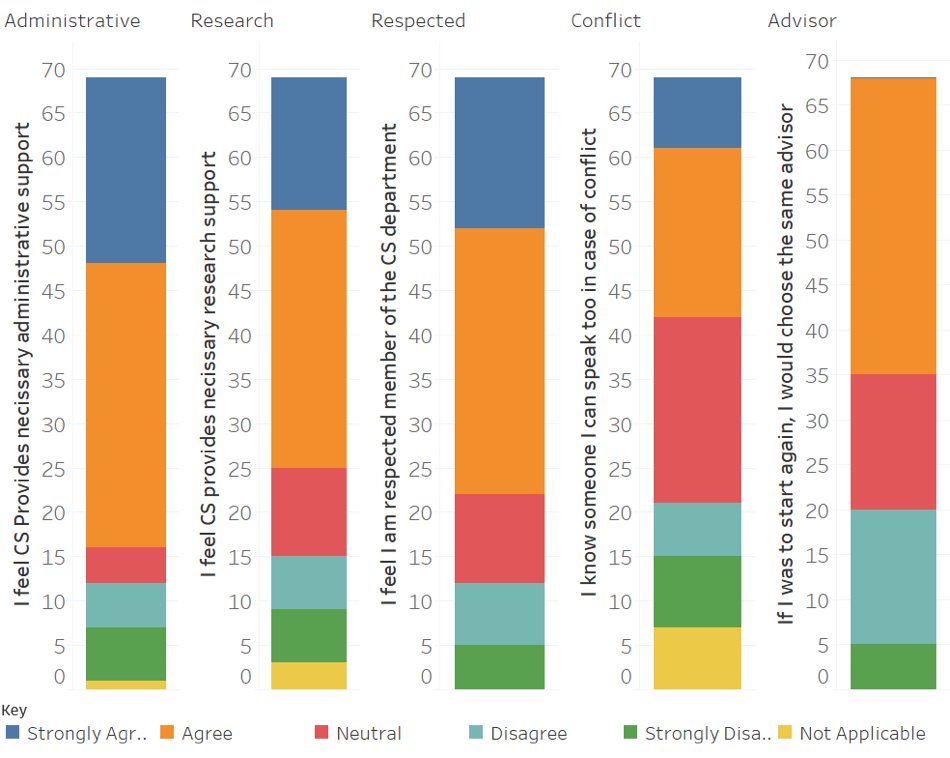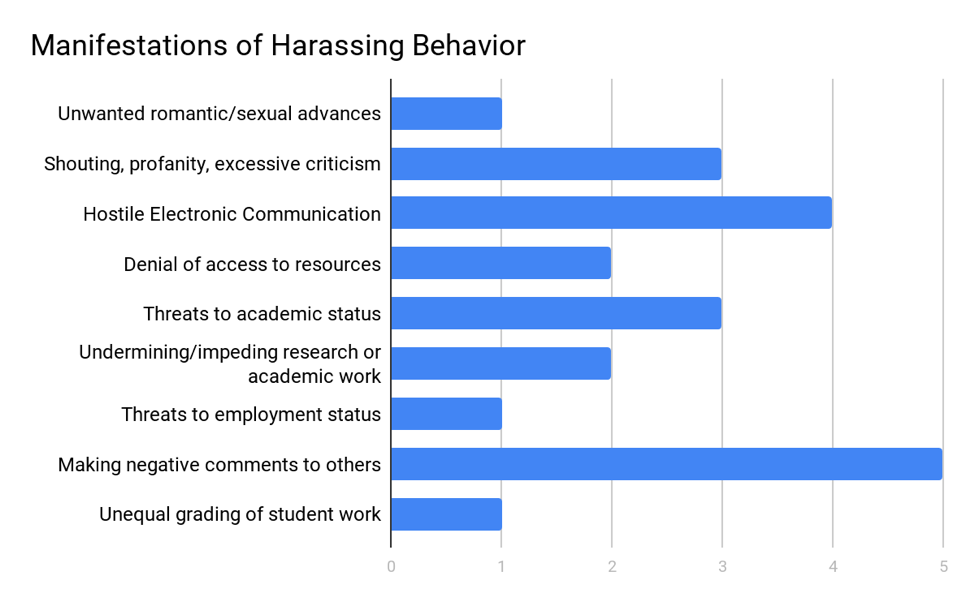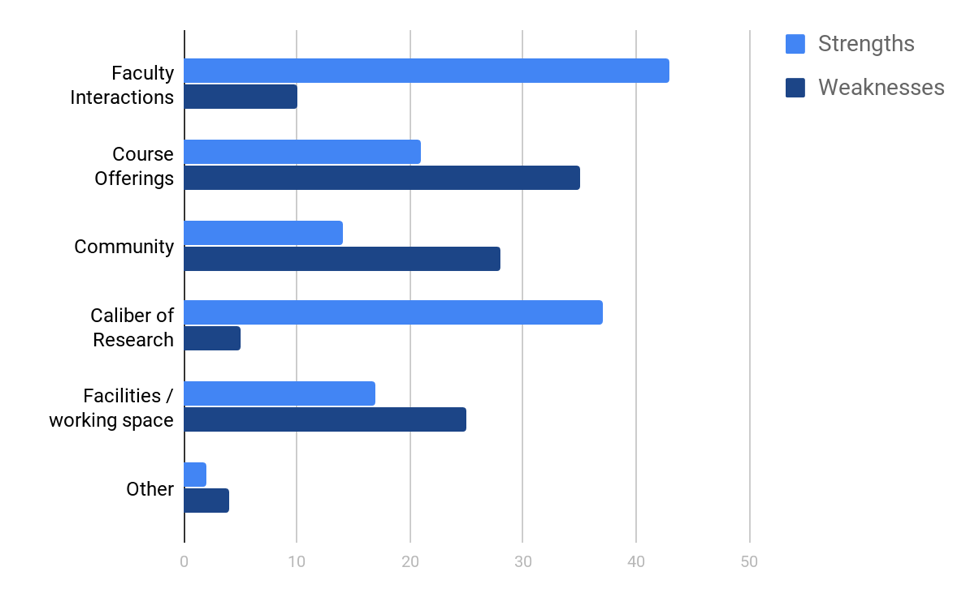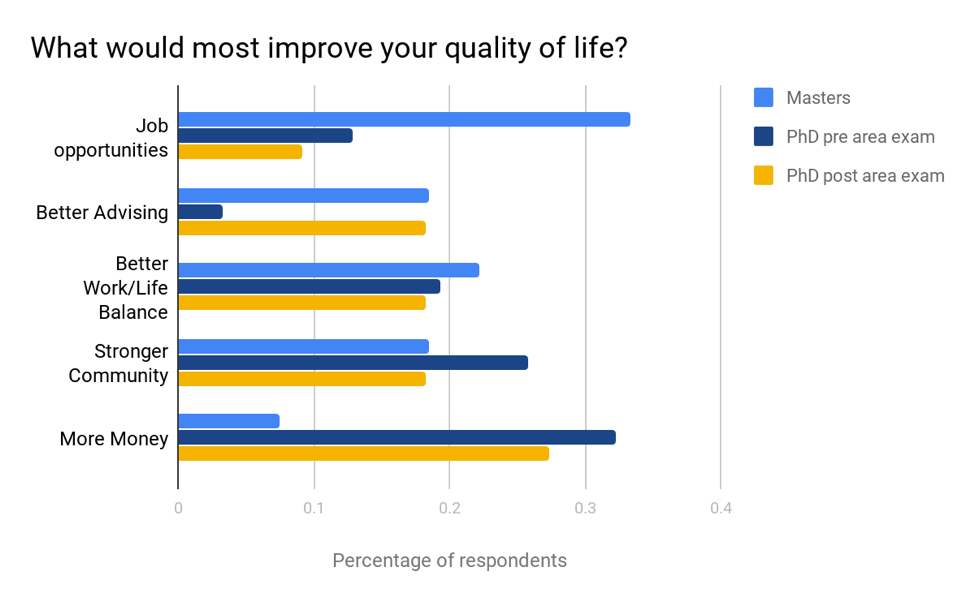Quality Of Life Survey Summary
RESPONSE OVERVIEW
We received 69 responses to the Climate Survey via Google Forms. Of those responses the breakdown is as follows:
- 27 Masters Students (39.1%)
- 31 PhD Students, pre area exam (44.9%)
- 11 PhD Students, post area exam (15.9%)
LIKERT SCALE QUESTIONS

HARASSMENT
6 students (9%) reported having observed harassment within the department, 3 Masters students and 3 PhD students. Each of these reports included multiple manifestations of harassment suggesting that these were not isolated incidents.

The harassment was usually reported to be experienced by graduate students although 2 reports included staff. The people committing the harassment varied, including staff, administrators, non-CS faculty, faculty advisors, and a person of unknown status, but the most frequently reported perpetrator was faculty (non-advisor) with 3 reports.
DEPARTMENT STRENGTHS AND WEAKNESSES
Respondents were asked to select strengths and weaknesses from a multiple choice list. They could choose to select multiple options.

Comments on Strengths
Students were asked to provide further information as to their selection of the departments strengths, these thoughts are summarized below.
- Faculty
- Collaborative
- Available
- Good mentorship
- Understanding and approachable
- Research
- Interdisciplinary
- Strong, cutting-edge
- Courses
- Good variety
- Other
- 6 respondents did not check any boxes for strengths. These were evenly distributed between Masters, PhD pre area exam, and PhD post area exam
- An additional 2 respondents, one MS and one PhD post area exam, choose to manually input “None” under the “other” category. In their comments, they reported strong dissatisfaction with the department. “There are no strengths. I would not attend this department if I went back in time.” and “I feel department needs to be improved a lot in terms of subjects being offered to MS students. Quality being maintained.”
Comments on Weaknesses
- Courses
- Lack/Scarcity of courses that fulfill breadth requirements
- Cater to undergrads and breadth requirements. Want more depth courses
- Quality of teaching is mediocre and variable
- Mixed graduate-undergraduate classes are useless for graduate students
- Some courses haven’t been offered in five semesters, but are listed on website
- Long wait lists
- Community
- Engineering Center is isolating. No common working area. No incentive to leave the lab.
- No feeling of belonging
- Few community events
- Students from some research areas are clique-ish
- Lack of interaction between research groups
- Facilities
- Lack of on campus study locations
- Department is fragmented across 5 buildings
- Old facilities need some TLC
- Frequent moves due to lack of space
- Other
- Stipends are too low relative to cost of living
- Faculty interactions with distance students are hostile
- Research labs are difficult for Masters students to join
- Too many administrative hoops to jump through with vague requirements
- 5 respondents did not check any boxes for weaknesses. These were roughly evenly distributed between Masters, PhD pre area exam, and PhD post area exam
What would most improve your quality of life?
Overall, respondents were almost equally split between the five options, but some interesting trends emerged when broken down by degree type. Masters students care a lot more about job opportunities, while many PhD students are hurting for money. There is also a large disparity between the number of Masters and PhDs for whom advising is the biggest issue. This might connect to the comment from the previous section that it is difficult for Masters students to find research labs to work in. Also, after the area exam, PhD students appear to care more about advising, although the post area exam sample is based on 2 out of 11 responses, so this might not be significant.

EVENTS
Likert Ratings

Event Suggestions
- Include distance learners (starting with town hall- set up Zoom session)
- Professional Events
- Meet with Alumni
- ACM-W chapter
- Workshops for after PhD
- Technology Fair
- Social Events
- Intramural teams
- Mixer with incoming students
- Graduation party
- Visiting dogs
TOPICS FOR DISCUSSION AT TOWN HALL
- Pay Schedules
- Cost of living in Boulder
- Improving Community
- Improving teaching
- Computational Resources (like AWS credits)
- What is an advisor supposed to do? (this question is from a master’s student)
SUGGESTED GOALS FOR THE DEPARTMENT
- Develop a written response to this document that can be distributed to graduate students, showing that their feedback is listened too and outlining actions that may be taken as a result. This can be combined with a similar such response from the CSGSA.
- Improve feedback loop between department and students, some issues raised here had previously been raised at the Fall Town Hall, and students received no update nor observed any change.
- Devote time in orientation or similar event to conflict resolution options (e.g. Ombuds) and harassment reporting options
- Address harassment with appropriate accountability and prevention procedures (e.g. a department specific harassment training for faculty)
- Introduce mentoring/advising option for masters students
- Create a graduate curriculum committee with a student representative
SUGGESTED GOALS FOR THE CSGSA
- Foster community within the department through a wider variety of social events and opportunities.
- Strive to include all members of the CS community in future endeavours, including distance learners, students with families, and students from underrepresented groups
- Work as a liaison between Department and Graduate student community communicate student views to the department and increase transparency about departmental response.
